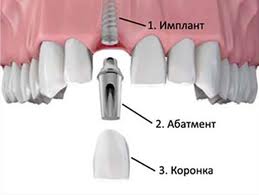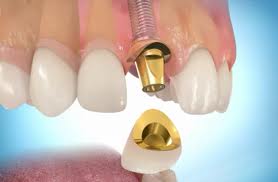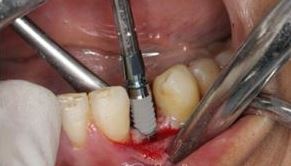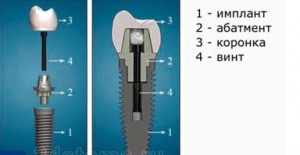Implant Dental Crowns

When it becomes necessary to restore lost teeth, the most beneficial solution for both the patient and the dentist is the installation of implants.
From both an aesthetic and functional point of view, dental crowns on implants are preferred due to the absence of the need to prepare the abutment teeth.
Thus, the risk of such complications as the occurrence of pulpitis, caries and other complications is excluded.
Crowns on implants restore both a single tooth and many missing teeth (using bridge structures).
To fix the crown on the implant, an adapter (abutment) is required, which is screwed into the implant.
Types of crowns
As a rule, crowns made of cermet and ceramic are fixed on the implants.
Cermet crown on implant

The ceramic-metal crown on the implant externally does not have distinctive features, compared with the ceramic-metal structure fixed on the prepared tooth.
The differences are in a more complicated manufacture and method of attaching the ceramic-metal crown to the implant.
The design is fixed to the abutment, which is pre-connected with the implant.
The protruding part of the abutment resembles in shape a stump of a tooth honed under a crown. After fixing the abutment on the implant, an artificial crown is installed on it.
Ceramic crown on the implant
Crowns mounted on implants can be made both from zirconium dioxide and from pressed ceramics. Crowns for implants and conventional designs have no external differences.
In order to install a ceramic crown on an implant, a ceramic abutment is required. If you fix the ceramics on a metal adapter, then it will shine through and give the tooth a dark blue hue.
How to install

- Initially, the implant is implanted into the bone tissue. An implant replaces the root of a lost tooth. The surgical stage of implantation lasts an average of four to six months
- After completion of the osseointegration process and successful implant engraftment, the stage of restoration of the crown of the tooth begins. After the gingival contour is formed (within two weeks), prosthetics is started.
- First, the necessary type of abutment is installed. After that, casts are taken and dental crowns are made. Thus, the delivery of the abutment and the manufacture of the prosthesis in the dental laboratory will take at least another two to four weeks.
Methods for fixing crowns
There are two ways to attach structures to implants:
Screw fixing

- With this fixation method, the connection of the crown with the adapter is performed outside the oral cavity.
- Then the design is screwed onto the implant with a screw.
- In this case, the chewing surface of the crown has a through hole through which a screw is passed.
- After fixing the crown on the implant, the hole is closed with a composite identical to the color of the crown.
Cement fixation
It is made as follows:
- The abutment is screwed onto the implant using a screw.
- After that, the tooth crown is fixed to the abutment using a special composite composition with cushioning properties.
Which fixation method is preferable
The safest, most convenient and reliable way is screw fixation of the structure.
This is explained by the fact that in the event of any problem, the crown can always be removed by first drilling cement and loosening the screw.
This is of greatest importance if the bridge structure has a large length and is fixed on several implants.
Screw fixation of crowns on implants is widespread in the USA and Europe.
In some cases, when the design is made carelessly, the bridge, consisting of several crowns, is not always possible to screw to all implants.
Fixing with cement helps to solve the problem, but it is also important to understand that it will be impossible to remove the bridge structure fixed to cement later on.
And when a problem arises with one of the implants, it’s even hard to imagine what awaits the entire structure. Previously, this method of fixation was quite common and was considered the norm.
Currently, with the advent of high-precision technologies for manufacturing structures, mistakes made in the manufacture of prostheses can occur only due to the low qualification of the orthopedist and dental technician.
Cost
The cost of crowns depends on what material it will be made of. The final cost is influenced by the type of abutment.
The cost of a ceramic-metal crown, including titanium abutment, is approximately from 10000 up to 14000 rubles.
Ceramic dental crowns on implants are much more expensive, because their price is the sum of the cost of the crown itself, including ceramic abutment, and is about 25,000 rubles.